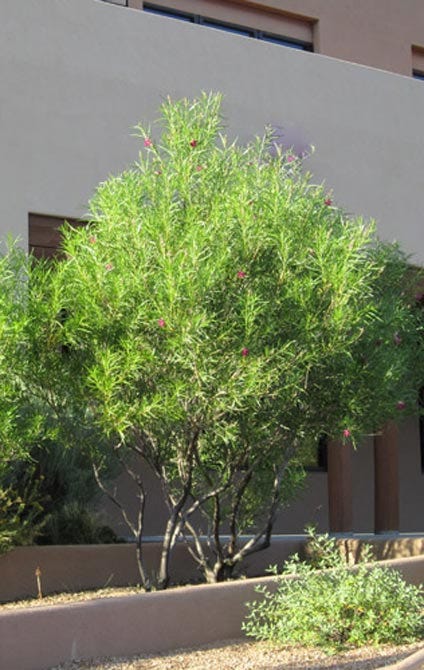by High Country Gardens

Desert Willow: A Colorful, Habitat-Friendly Native Tree
Desert willow (Chilopsis linearis) is a fabulous small growing native tree loved for its showy, tropical-looking flowers. Native to the Southwestern United States, the plant is not widely known, but deserving of wider use. It is closely related to Catalpa, Tecoma, and Campsis, all members of the Bignoniacea family. Attributes such as fast growth, heat tolerance, ease of care, and tolerance to drought make it a desirable addition to the waterwise garden.
I have been fascinated with the plant for many years, and I am successfully growing it here at a high elevation in USDA zone 6 Santa Fe, NM. My efforts to find the most beautiful and cold hardy selections have paid off with three named varieties in production and more on the way in the future.
Fall: The Ideal Time to Plant in Zones 7-10
For gardeners and landscapers in USDA zones 7-10, fall is the ideal time to plant Chilopsis. The plants will establish their roots over the winter and spring months to be ready for explosive growth with the heat of next summer. For those of us in USDA zones 5 and 6, it's best to wait for spring to plant. The plant needs a long summer of hot temperatures to establish itself sufficiently to make it through a cold winter.
Chilopsis: A Wonderful Garden Resident
Chilopsis is invaluable as a plant for the habitat garden. Like other pollinator plants, the flowers are a rich source of nectar for hummingbirds, bumblebees and butterflies. As a landscape plant with thin leaves and an open canopy, I love the dappled shade it provides. Many partial-shade loving plants will thrive underneath its branches.
Desert willow is a good choice for planting on the edges of water retention basins and rain gardens. It grows naturally along dry arroyos where it experiences both wet and dry conditions.
Exceptional Varieties Ensure Excellent Results
Many Big Box stores sell cheap, seed-grown Desert Willows. But the plant is highly variable, and trees grown from seed will have unknown cold hardiness. And you can't be sure if it will have undesirable characteristics, such as excessive seed pods, small pale flowers, and ungainly growth. I strongly suggest purchasing named selections that are grown from cuttings to be sure you get the most desirable plants.
Lucretia Hamilton©
Introduced by Ron Gass of Mountain States Nursery in Glendale, AZ, Ms. Lucretia is a smaller growing specimen topping 12 ft. in zones 5 and 6, getting a bit larger in milder winter areas. The large fragrant flowers are a solid deep burgundy in color. It's long blooming because it sets very little seed. Lucretia Hamilton© is an excellent choice for small patios and courtyards and very cold hardy once established. The original plant was grown from seed collected at the Los Lunas Plant Materials Center, south of Albuquerque, NM.
'Paradise'
Discovered and introduced by Steve Bieberich of Sunshine Nursery and Arboretum in Clinton, Oklahoma, 'Paradise' is a very large growing selection of Chilopsis. Maturing at 20 to 25 ft. in height, it is large enough to become a flowering shade tree. It blooms with large clear pink, fragrant flowers, and it has atypical, slightly broader and deeper green leaves. Steve lives in the panhandle of western Oklahoma, which has sizzling summer temperatures that can plunge well below zero in the winter. 'Paradise' has excellent cold hardiness once established.
'Conchas Dam Pink'

I discovered a stand of Chilopsis growing on the high plains of eastern New Mexico, just downstream from Conchas Reservoir west of Tucumcari. It now appears that this is the northern most population currently known. A good choice for small yards and patios, 'Conchas Dam Pink' matures to about 12 to 15 ft. in height with an equal width. It has excellent heat tolerance and exceptional cold hardiness once established.
Text and Photos by David Salman
©All articles are copyrighted by High Country Gardens. Republishing an entire High Country Gardens blog post or article is prohibited without permission. Please feel free to share a short excerpt with a link back to the article on social media websites, such as Facebook and Pinterest.